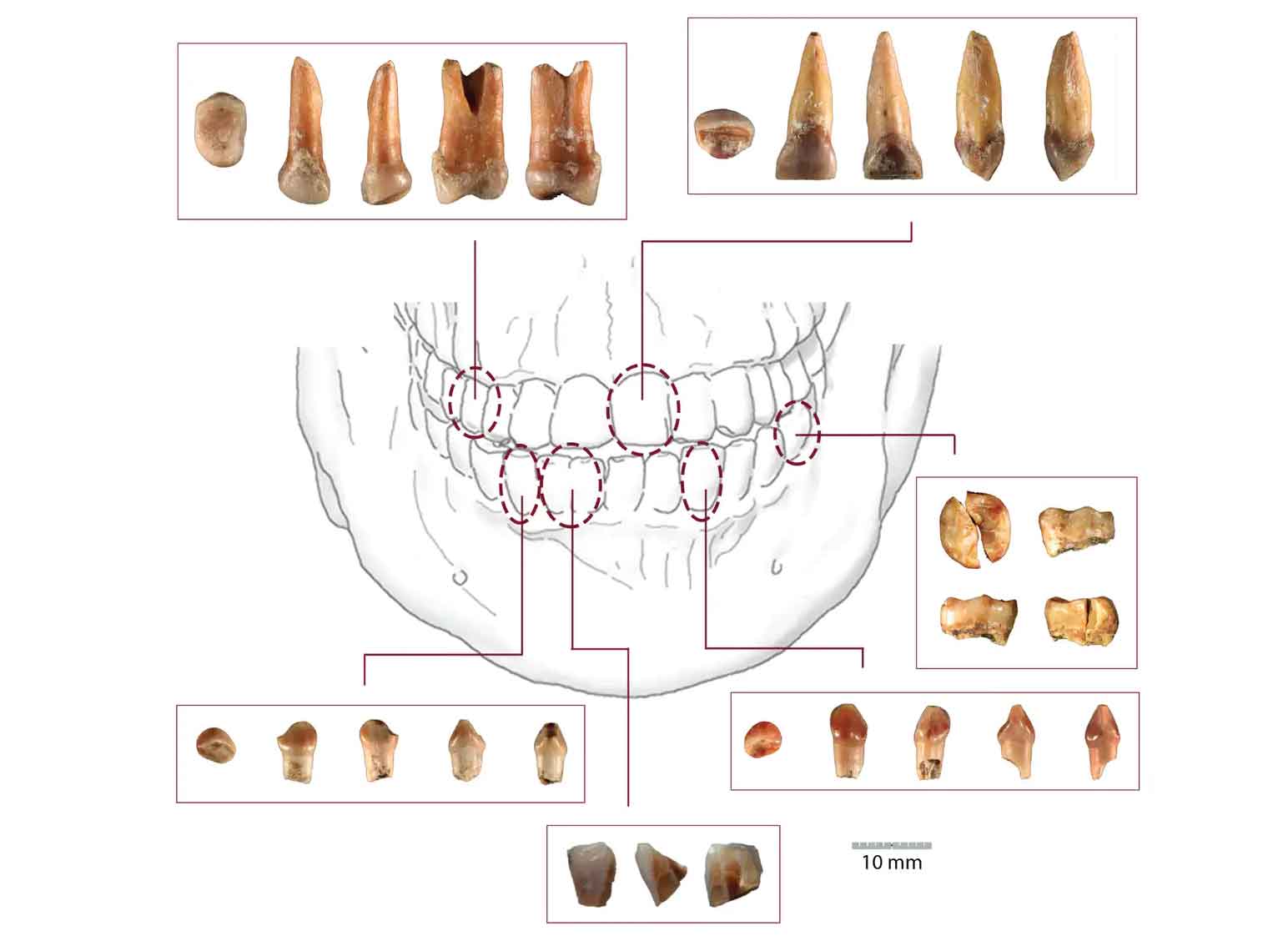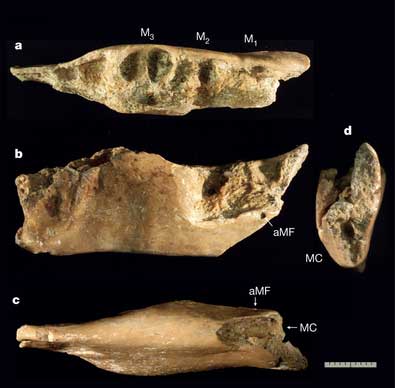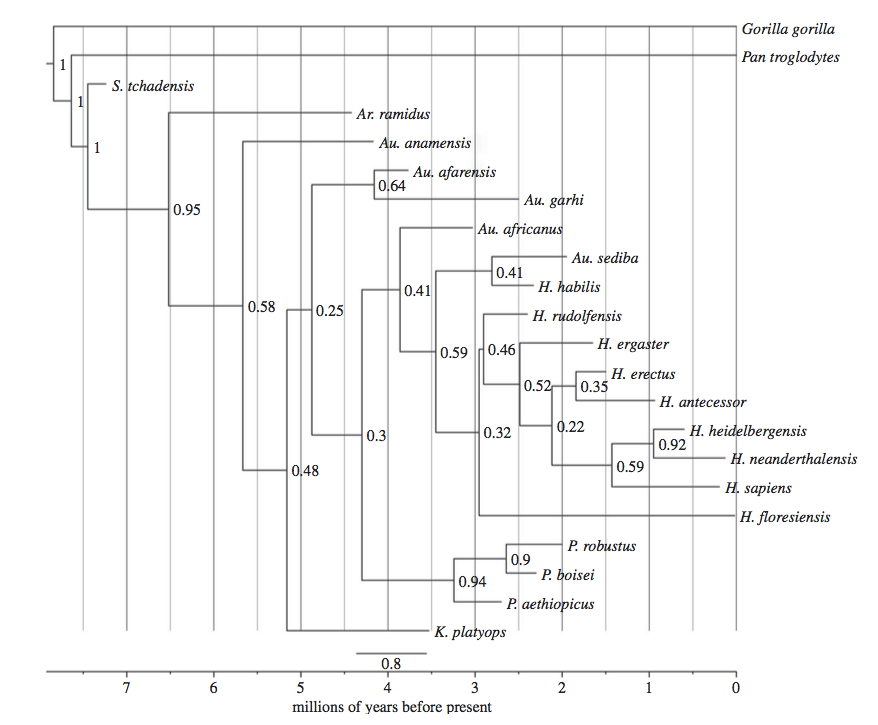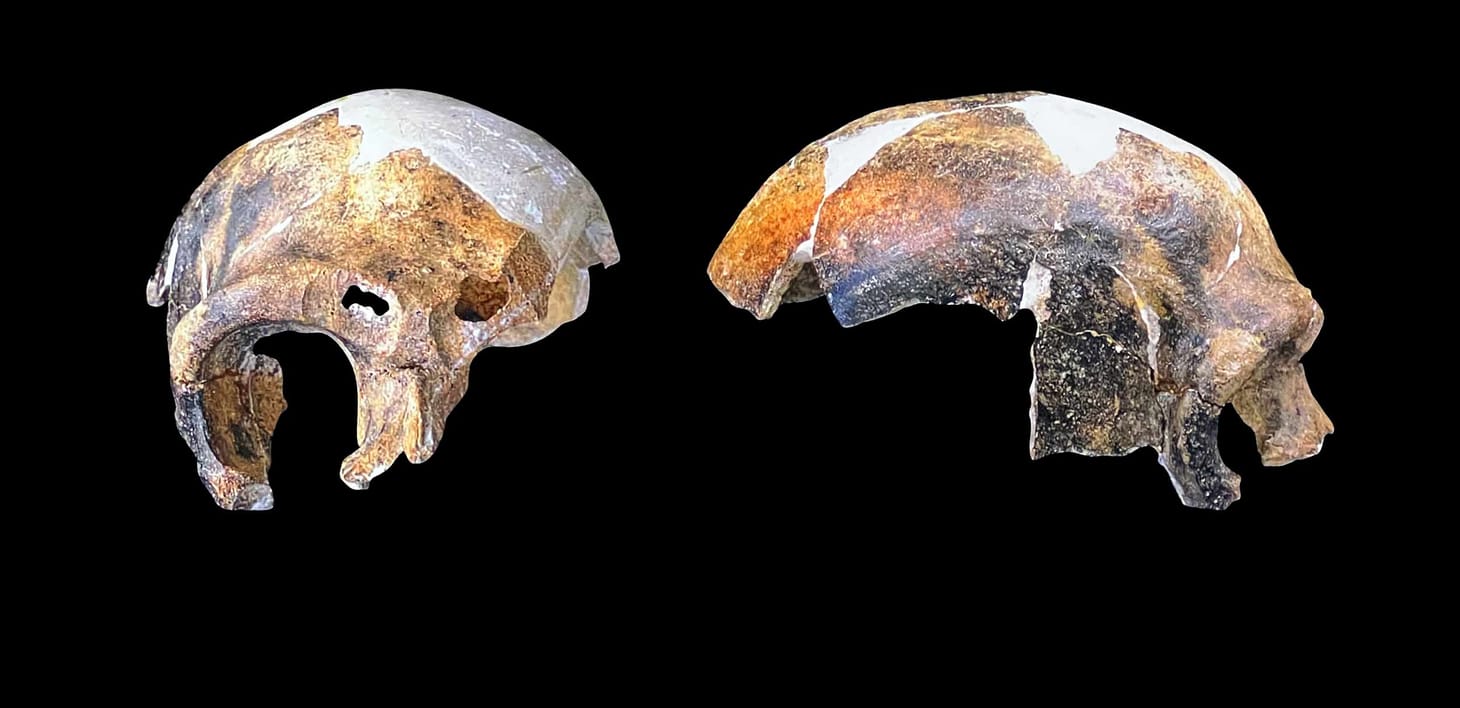An possible ancestor of Homo floresiensis from the Middle Pleistocene of Flores
Gerrit van den Bergh and coworkers describe dental remains and a jaw from Mata Menge, 700,000 years ago.

I was really excited yesterday to read about the work of Gerrit van den Bergh and colleagues at Mata Menge, where they have uncovered hominin fossil remains attributable to an ancient population on Flores. The six teeth and one partial jaw were recovered from a “high-volume” excavation covering more than 200 square meters. They document the existence of a small-toothed and small-jawed human population on Flores approximately 700,000 years ago.

Phylogenetic position of the Flores hominins
Earlier this spring, I reviewed the work by Sutikna and colleagues that revised the timeline of the Liang Bua hominin sample (“What the revised Liang Bua chronology leaves unanswered”). All of the remains of small-bodied hominins from Liang Bua now predate 60,000 years ago, making them earlier than the first known occurrence of modern humans anywhere in Indonesia. Paleoanthropologists have generated rival explanations for the phylogenetic relationships of the Liang Bua skeleton. Some propose that it represents evolutionary dwarfing from a larger-boded Homo erectus ancestor; others hypothesize that a previously unknown population of australopiths or smaller-bodied Homo may have existed in Asia and given rise to the Flores population.
LB1 preserves most of a skeleton, providing the potential for Homo floresiensis to be one of the most well-represented species in any phylogenetic analysis of the hominins. Most other hominin species are represented only by jaws and teeth, and maybe parts of the face and cranial vault. Yet despite the richness of evidence from LB1, its phylogenetic position remains uncertain.
The biggest problem is not the LB1 skeleton, it is the lack of evidence from other species.
To understand the scope of the problem, we can look at the two most recent attempts to place the LB1 specimen into the hominin phylogenetic tree. Both considered only the morphology of the skull, mandible and teeth. Valéry Zeitoun and colleagues (2016) concluded that LB1 lies within the variation of early H. erectus specimens from Java, including the Sangiran 2 and 17 specimens, the Trinil 2 specimen, added to the KNM-WT 15000 skull. They concluded that later “H. erectus” specimens from Java belong to a different clade, closer to Middle Pleistocene humans elsewhere and modern humans.

Meanwhile, Mana Dembo and colleagues (2015) concluded that H. floresiensis is an outgroup to a clade including H. rudolfensis, H. erectus and later species of Homo (but not H. habilis). However, the Bayes factor comparisons in this study could not reject the hypothesis that the closest sister group for H. floresiensis was H. erectus.

Those are two very different conclusions. The analyses included different groups of fossils, grouped them in different ways (species versus individual specimens), and looked at different sets of characters, with a different pattern of missing data. In the end, although the Bayes factor analysis by Dembo and colleagues (2015) did not look at the precise scenario favored by Zeitoun and colleagues (2016), it did show that a similar scenario cannot be rejected by the data. In the end, the data just aren’t good enough to tell between these.
It gets worse. Looking at whole-body evidence from hominin populations, it is evident that the few features of skulls and teeth that determine the outcomes of phylogenetic analyses are not necessarily typical of the skeleton as a whole. When we look at basal lineages within Homo, like populations of Homo erectus, Homo habilis, Homo rudolfensis, and Homo floresiensis, we are looking at a series of branches that diverged very close to each other, probably within a million years and potentially within a few hundred thousand years, which means that there may be few shared derived features linking the species within a clade. Yet some of those branches may be very long, particularly Homo floresiensis, meaning that there is a strong chance that the signal of phylogenetic relationship will be lost within the noise of long, independent evolutionary history.
I will add that there is a very real possibility of population mixing and introgression during the initial evolution of Homo, that would tend to obscure any simple tree of relationships among these species.
Homo floresiensis is not a uniquely confusing case. We face similar issues with the very complete skeletal evidence from Homo naledi. More evidence does not make this species easier to place on the phylogeny of Homo. In many ways, better evidence just directs our attention to how poor our efforts using partial jaws and teeth must be.
In that context, it is probably hopeless to expect that a partial fragment of jaw and six teeth are going to add useful data to better understand the phylogenetic context of the Flores hominins. Some people have commented that the Mata Menge teeth are “erectus-like”, or more similar to H. erectus than to H. habilis. I find the data unpersuasive. The jaw is unquestionably smaller than any adult mandible assigned to H. erectus, H. habilis, or H. naledi, as is the lower molar (whether it is a first or second) and the premolar. The small sizes of all these elements would be derived relative to any primitive species within Homo, so being closer in size to H. erectus is not useful information—after all, they are even closer in size to H. sapiens!
The deciduous canines and the central upper incisor stand out as unusually small and not morphologically typical of modern humans or fossil Homo erectus, but they are approximately the same sizes as the deciduous canines of Homo naledi. If no one else has suggested that H. naledi gave rise to the Flores hominins, I’ll be happy to be the first.
The mandibular corpus preserves no diagnostic morphology other than its small size, and it is within the range of sizes of modern humans. There are only a few non-metric traits of the teeth that can be assessed, which are shared with specimens of H. erectus and H. habilis, and the shape of the molar is more erectus-like than habilis-like. That’s weak evidence, since the small size of the molar probably confounds its shape (it’s like modern humans in shape as well). If these specimens had been recovered from the surface instead of from an excavation, they would have been difficult or impossible to authenticate as representing an ancient population. There’s just too little evidence there.
Flores reinvasion?
The authors of the research have done well by not over-emphasizing the quality of the morphological evidence in their research paper. The remains do not share any of the traits used to diagnose Homo floresiensis, which justifies the caution of van den Bergh and colleagues in not assigning them to that species.
The remains also do not settle whether small body size had appeared in the Mata Menge hominins. Some commentators seem to be assuming that these teeth do belong to the same population as the later Liang Bua remains, and are inferring a small body size on the basis of a slightly smaller size than the Liang Bua mandibular and dental sample. But nowhere else in the hominin fossil record would we be safe in assuming that jaw and tooth size are good indicators of body size, and I think the assumption is unwarranted here.
It is certainly possible that the small Mata Menge teeth and jaw represent a similarly small-bodied population, and I would not be surprised if the next bone to be discovered was a tiny tibia along the lines of LB6. But the next most comparable species for the sizes of the teeth are modern humans and Homo naledi, neither of which are nearly so small in body size as LB1 or LB6 from Liang Bua. More broadly, body size and tooth and jaw size are not well correlated among hominin species. There are notably big-toothed and small-bodied Homo erectusspecimens, and smaller-toothed and big-bodied Homo erectus specimens. These teeth and this jaw are within the size range of modern human jaws and teeth; their bodies may have been as well.
Realistically, the morphology can give little indication that the Mata Menge hominin sample represents an ancestral population for the later Liang Bua sample. As some have pointed out, Flores may have been invaded more than once by hominin populations, and such populations may independently have evolved small mandible and tooth sizes, or even small body sizes.
To know that reinvasion is a plausible scenario, we need look no further than the local proboscideans. Flores was invaded at least twice by successive Stegodon species that apparently did evolve smaller body size independently. These creatures are abundant in the fossil record of Mata Menge and Liang Bua, and they likely existed at higher population densities than the hominins—even though elephants in general live at fairly low densities when compared to other smaller terrestrial herbivores. The idea that Flores could not have been reinvaded by hominins seems to be based on the assumption that the ancestral population arrived by accident and constituted a “lost world” phenomenon. I wouldn’t make that assumption.
Moreover, there’s a problem with the “lost world” hypothesis. If hominins on Flores had the same low population densities as we think characterized continental hominin populations during the Pleistocene, there couldn’t have been many of them. Such a population would have been more or less constantly at risk of extinction or mutational meltdown. It may not have been viable over evolutionary time.
Flores may have even undergone periods of complete abandonment followed by the introduction of new founder populations. Or new immigrants from a larger population may have had a genetic advantage within the strongly inbred Flores population. In either case, strong genetic and population turnovers may have occurred repeatedly, even if (maybe especially if) migration to the island was rare. I would even speculate that repeated entry of new populations onto Flores was accompanied by some introgression from the earlier population, if it was not extinct. Maybe small body size really did evolve a single time, and was retained over time due to adaptive introgression.
The founders of Flores populations may have come from the same source population or from different sources. As Chris Stringer pointed out in his public comment, the source population for Flores may well have inhabited Sulawesi, in which case the source population may itself have been a dwarf population of hominins, although larger in numbers than would be sustainable on Flores. For that matter, the body sizes of Javan and Chinese H. erectus populations were not as large as those reported for East African Early Pleistocene H. erectus.
This is all unfounded speculation, but it is consistent with what we know (and don’t know) about the hominin fossil record and our knowledge of evolutionary processes. I remain excited about the recovery of evidence from Mata Menge, but that excitement is tempered by the inability of the evidence to test many interesting hypotheses.
Fast evolution of small body size?
Last, I’m very surprised to see paleoanthropologists in the press commenting that the dwarfing of Homo floresiensis was very rapid. The data are completely silent about the rate of evolutionary change in this case. To assess evolutionary rate, we need to know both the magnitude of change and the time available for change to have occurred. In this case, we know neither.
First, we simply do not know the body size of the Mata Menge hominins. Second, even if we assume they were small-bodied, we do not know the body size of their ancestral population. If they evolved from something like Dmanisi, we are talking about a rather minor amount of size reduction. If they evolved from an australopith-like ancestor, we may be looking at stasis in body and brain size.
Third, we have absolutely no reason to think that 300,000 years is the total time available for the evolutionary change. The first occurrence of archaeology on the island must be later thanthe first appearance of hominins. The artifacts from Wolo Sege show hominin activity prior to 1 million years ago, and Brumm and colleagues (2010) concluded that the existing sedimentary record of the Soa Basin “may not be old enough to register the initial arrival of hominins on the island.” We have no reason to assume that the date of the Wolo Sege artifacts was close to the arrival time.
Indeed, if Dembo and colleagues were correct about the evolutionary relationships of H. floresiensis, their estimate for the origin of the branch leading to the species is nearly 3 million years ago. Is it possible that hominins were on Flores more than a million years before the Wolo Sege artifacts? Maybe so. We cannot test the hypothesis at present.
This goes to a broader problem in paleoanthropology: Too many of our professional colleagues assume that the origin of a species can be equated with its first occurrence in the fossil record. It would be worse than foolish to assume that the record is good enough to document the earliest occupation of Flores by hominins. The literature on the subject tells us directly that the record is not good enough to test when hominins arrived on the island.
So we do not know the rate of evolutionary change in this case. I will add just say one more thing: Three hundred thousand years is a lot of time. It is more time that we used to imagine for the initial expansion of body and brain size in Homo erectus. It is plenty of time for selection to transform body and brain size in a hominin population.
References
van den Bergh, Gerrit D., Yousuke Kaifu, Iwan Kurniawan, Reiko T. Kono, Adam Brumm, Erick Setiyabudi, Fachroel Aziz and Michael J. Morwood. Homo floresiensis-like fossils from the early Middle Pleistocene of Flores. Nature 534, 245–248. doi:10.1038/nature17999
Brumm, Adam, Gerrit D. van den Bergh, Michael Storey, Iwan Kurniawan, Brent V. Alloway, Ruly Setiawan, Erick Setiyabudi, Rainer Grün, Mark W. Moore, Dida Yurnaldi, Mika R. Puspaningrum, Unggul P. Wibowo, Halmi Insani, Indra Sutisna, John A. Westgate, Nick J. G. Pearce, Mathieu Duval, Hanneke J. M. Meijer, Fachroel Aziz, Thomas Sutikna, Sander van der Kaars, Stephanie Flude and Michael J. Morwood. Age and context of the oldest known hominin fossils from Flores. Nature 534, 249–253. doi:10.1038/nature17663
Brumm, Adam, Gitte M. Jensen, Gert D. van den Bergh, Michael J. Morwood, Iwan Kurniawan, Fachroel Aziz, and Michael Storey. 2010. Hominins on Flores, Indonesia, by one million years ago. Nature 464, 748-752. doi:10.1038/nature08844
Sutikna, T., Tocheri, M. W., Morwood, M. J., Saptomo, E. W., Awe, R. D., Wasisto, S., ... & Storey, M. (2016). Revised stratigraphy and chronology for Homo floresiensis at Liang Bua in Indonesia. Nature. doi:10.1038/nature17179
Zeitoun, Valéry, Véronique Barriel, and Harry Widianto. 2016 Phylogenetic analysis of the calvaria of Homo floresiensis. Comptes Rendus Palevol 15, 555-568. doi:10.1016/j.crpv.2015.12.002
Dembo, Mana, Nicholas J. Matzke, Arne Ø. Mooers, and Mark Collard. 2015. Bayesian analysis of a morphological supermatrix sheds light on controversial fossil hominin relationships. Proc. R. Soc. B, 282, 20150943. doi:10.1098/rspb.2015.0943
John Hawks Newsletter
Join the newsletter to receive the latest updates in your inbox.



